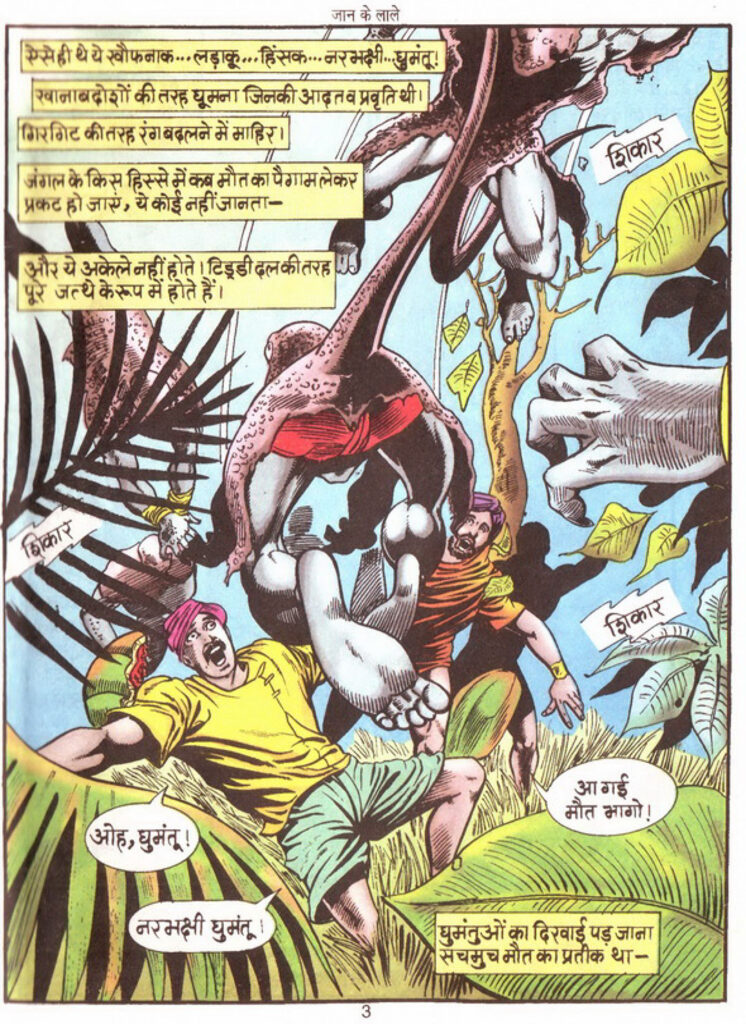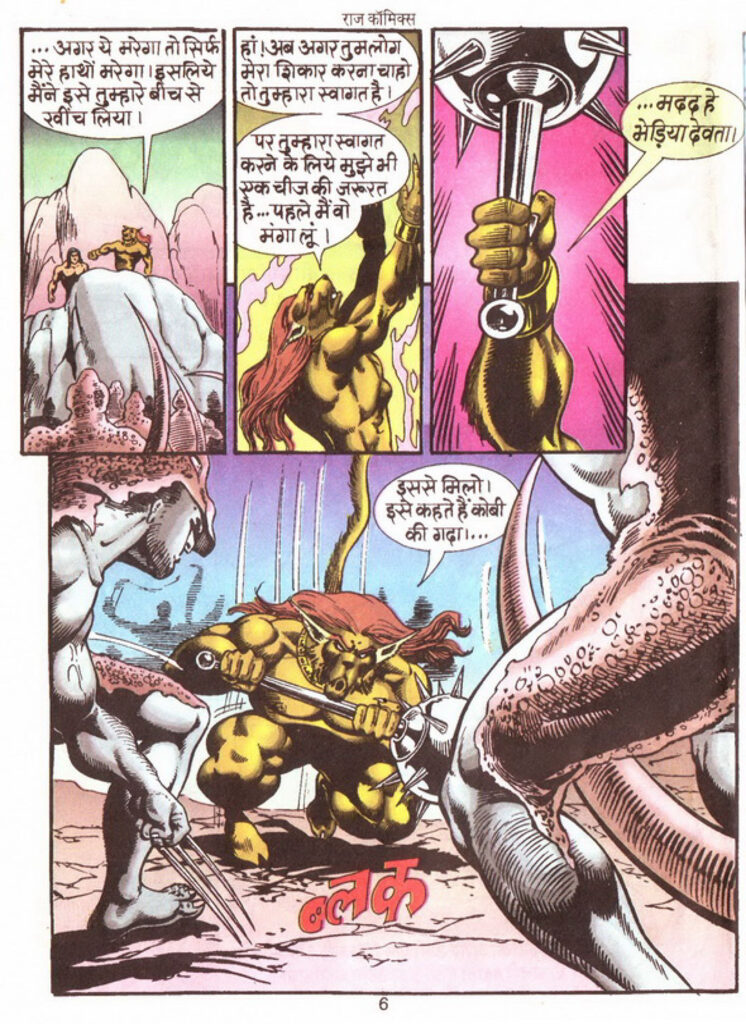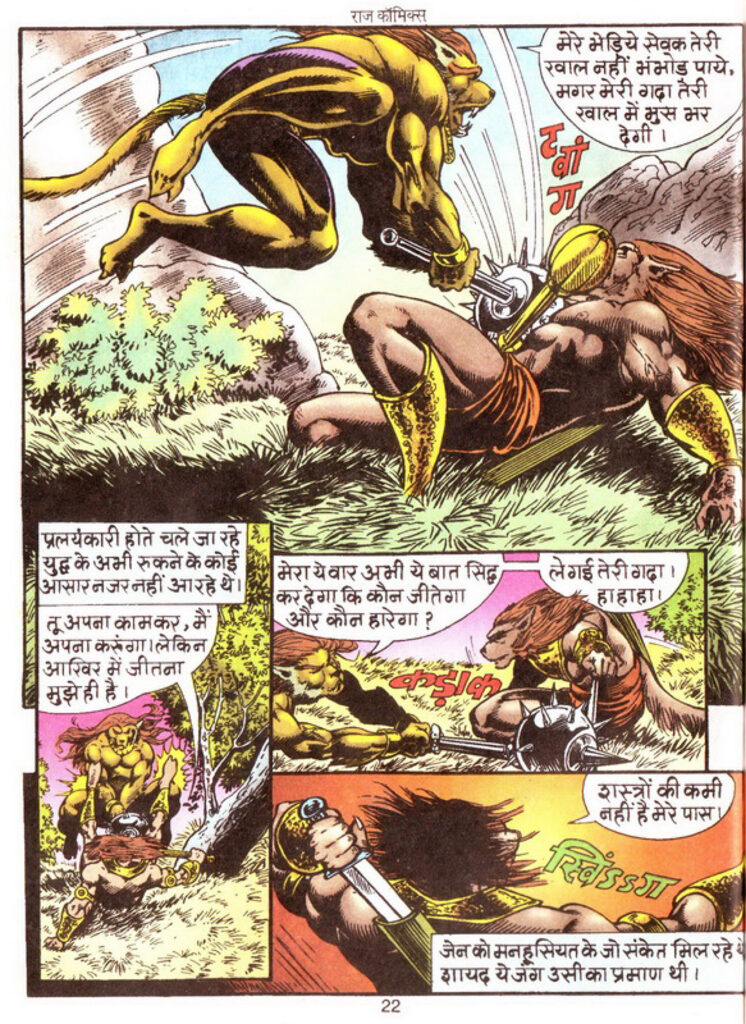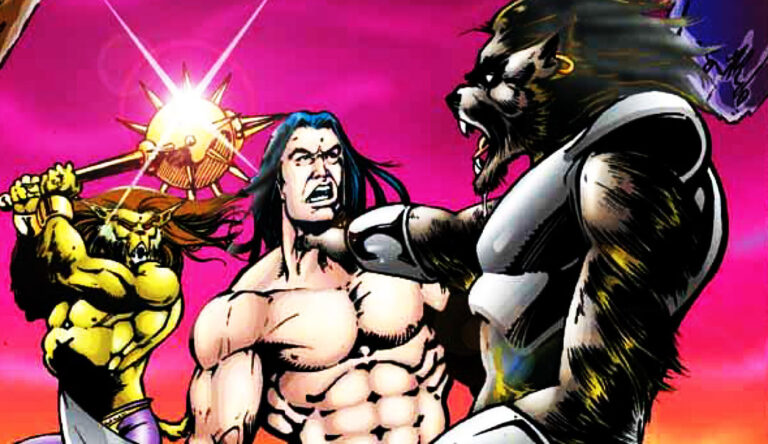This review is based on Raj Comics’ very special and thrill-filled special issue “Jaan Ke Lale”. This comic mainly revolves around two big and fan-favorite characters—Cobi (Kobi) and Wolf (Bhediya). The story not only shows the emotional storms going on inside these two and their deep bond, but also contains cosmic elements, mythological glimpses, and explosive action in a very fun way. In this long review we will talk about the plotline of the story, the characterization, the technical merits, and its deep messages in quiet, easy, and understandable language.
Detailed Review of “Jaan Ke Lale” (Kobi Aur Bhediya)
I. Introduction and Initial Analysis of the Plot (Introduction and Initial Spot Analysis)
“Jaan Ke Lale” is one of those stories in Raj Comics which shows readers a new, scary, and exciting face of the world of Kobi and Bhediya. The concept of this special issue is by Vivek Mohan, the story has been written by Tarunkumar Wahi, and it has been decorated by Dheeraj Verma with his powerful and life-giving illustrations.

The story begins with a major cosmic accident—signs of collision of two planets begin. One planet is the creator of Suryamala, Phobos (Phobos), and the other is Mobos (Mobos), a symbol of destruction. This element is quite unique to Raj Comics because it shows that the story is not limited to just Earth, but cosmic forces also shake the fate of Kobi and the Wolf. Due to this cosmic shock, the bodies of Kobi and the Wolf, in which their souls lived, get separated and turn into two separate entities.
On one side after separation is Kobi—a powerful, human-bodied warrior. On the other side is the Wolf—a powerful wolf-shaped creature with a glimpse of spirituality and peace. Both of their personalities were earlier tied in one body, but as soon as they separated, their true nature came to light. The Wolf is calm, understanding, and spiritual, while Kobi emerges angry, sharp, and the real executioner of the forest.
II. Plot Expansion: Conflict and New Enemies
The Rise of Nomadic Cannibals (The Rise of the Ghumantu Cannibals)
Kobi’s first collision as soon as he separates is with ‘nomadic cannibals’. They are a swarm of nomadic, violent, and extremely dangerous creatures who change color like chameleons and wreak havoc wherever they go like locusts. Kobi, with his tremendous strength and brutal blows, dusts and drives these cannibals out of the forest. This early fight shows that Kobi is not just strong—he is also the real protector and punishing executioner of the forest, as the Wolf always says.
Fainting and Reicha Penetration (The Entry of Murccha and Reicha)
The big twist of the story comes when the Wolf, sensing the cosmic crisis, is on his way with his partner Jane to Fujo Baba, the wise Vaidya of the forest. It is during this time that Kobi encounters a mysterious hunter who tries to lure him into a trap. This predator is none other than Murccha—a creature that appears wolf-like and claims to have come to capture Kobi.
Meanwhile, suddenly another unique and strange force creature, Reicha (Reicha), appears. He also takes Kobi out of the trap of Murccha and at the same time attacks him. Kobi vs Reicha and Wolf vs Murccha—both sides spark the fire of war. Amidst this confrontation, a big secret is revealed—both Murccha and Reicha are messengers of Kobi and Bhediya’s guru, Gururaj Bhatiki.
III. Revelation and the Central Crisis
Murccha and Richa tell that they had come on the orders of Guru Bhatiki to keep Kobi and the Wolf locked in the underworld for the entire twenty-four hours. The reason for this was that in the coming twelve hours, a dangerous cusp star is going to pass near the Earth with its destructive power. During this time, if Kobi and the Wolf remain free, they can cause huge damage to the forest or even humans in anger and madness.
According to the old texts of Guru Bhatiki, this devastating crisis occurs once every five thousand years, and at this time the wolf-humans go out of human control and become extremely violent. Murccha and Richa say that during this period, wolf-humans can shed rivers of human blood and their anger is not in anyone’s control.

But because Murccha and Richa could not succeed in catching Kobi, the burden of the real crisis now falls on Fujo Baba’s shoulders. He has to understand this dangerous situation and find a solution to it.
Mace of the Evil Tree and the Wolf God
Fujo Baba remembers that the solution to stop this crisis is hidden in the cross made from an ancient and mysterious evil tree. In ancient times, wolf-humans were kept tied on crosses made of this wood until the devastating crisis was averted. But this evil tree can be plucked only with the mace of the Wolf God—and that mace is currently with Kobi.
Since Kobi will never believe what his opponents say (Murccha and Richa), Fujo Baba and the Wolf make a secret and sensible plan—
- Tying Jane on the evil tree.
- The Wolf’s insistence on releasing Jane in front of Kobi.
- Kobi’s angry attempt to break the tree so he can save Jane.
IV. Climax: The Fake War and Final Sacrifice of the Kobi-Wolf
Kobi and the Wolf start fighting among themselves under the pretext of saving Jane. Actually, this fight is just a show—the whole fight is part of the same plan by which the dreaded tree can be broken. The Wolf repeatedly provokes Kobi. Eventually, Kobi boils in anger and hits the Durdum tree hard with his mace.
The power of Kobi is so terrible that the dreaded tree gets shattered. After that, Fujo Baba prepares many crosses from those broken pieces of wood.
And now the most emotional part of the story comes—the Wolf himself comes forward and stands on the evil cross and asks Fujo Baba to nail him.
Fujo Baba does this while crying, because this is the Wolf’s sacrifice to save the forest. He knows that if he is not stopped, he can become a threat to anyone in a time like the Holocaust.
This is the biggest philosophy of the self-sacrifice story—to sacrifice yourself to save your loved ones and your forest.
The next part (which appears in the second comic under the name “Saleeb”) shows Kobi’s role, Jane’s efforts, and Fujo Baba’s challenges during the same crisis.
V. Portrayal of Characters (Character Analysis)
Kobi (Kobi)
Kobi is a combination of strength, anger, and ego. He is the executioner of the forest—violent but also extremely emotional and protective from within. His physical strength is limitless, and his mace is the greatest weapon of his anger. Kobi’s character is not straightforward—he also has concerns for Jane, but he trusts his strength so much that he never takes dangerous enemies like Murccha and Recha seriously. His real anger is not on the Wolf, but on the cosmic force that has broken him from within and which he is unable to control.

Wolf (Bhediya)
The Wolf is completely different from Kobi. He is a symbol of strength as well as mind, wisdom, and emotional depth. The commotion in the forest—bats, crows, buffaloes, everyone’s restlessness—is felt by him first. His struggle is not just a fight, but also an emotional and mental struggle coming from within. The Wolf quickly understands that he can be defeated in strength by Murccha and Recha, so he teams up with Fujo Baba to create a dangerous but smart plan to trick Kobi. His last step—getting himself nailed to the cross—makes him a great, sacrificial, and true hero.
Murccha and Recha (Murccha and Recha)
Both of these characters further reinforce the severity of the crisis. They are very powerful, loyal, and trained messengers of Guru Bhatiki. They have unique powers—the poisonous mace of Murccha that makes the other person dizzy, and the miraculous sword of Recha that cuts even a stone and takes the opponent captive by throwing a net. Their presence also poses a challenge to deadly warriors like Kobi and Bhediya, which shows that both of them are not any common fighters but extremely dangerous and high-level warriors.
Fujo Baba and Jane (Fujo Baba and Jane)
Fujo Baba is a treasure trove of knowledge, spiritual power, and old secrets of the jungle. He even understands the language of animals and birds. It is his understanding that reveals that the solution to this big crisis is hidden in the dreaded tree. Fujo Baba’s cry over the Wolf’s sacrifice deepens the painful truth of this incident.
Jane shows the human side of the Wolf in the story. Her anxiety, her fear, and her emotional moments give a human touch to the story and show how important relationships and emotions are even in the midst of this great crisis.
VI. Artistic & Technical Analysis (Artistic and Technical Analysis)
Illustration (Art by Dheeraj Verma)
Dheeraj Verma’s art is the life of these comics. He has shown the muscularity of the characters’ bodies and the speed of the action scenes so beautifully that every panel seems alive. The bodies of both Kobi and the Wolf—their anger, their pain, and the severity of their faces—are all so closely drawn that the reader goes straight into the story.

Mobility:
Action scenes like Kobi’s attack on the nomads or Recha’s fencing look very strong and powerful. Sound effects such as “dhay”, “bittar-dak”, “taveng” during strikes make the action more fun.
Color Combination:
The colors of the comic are bright as well as dark, giving the perfect balance of both. Kobi’s green-violet dhoti, Wolf’s golden physique, the glow of cosmic scenes, and the pink-yellow lightning of Kobi’s mace strike all combine to greatly enhance the visual impact.
Writing and Dialogue
Tarunkumar Wahi’s style of writing gives a fast pace to the story.
Screenplay:
Starting the story with a big cosmic bang and then gradually moving towards personal struggles makes the story both big and emotional. Kobi and the Wolf fighting among themselves in the name of saving Jane, and the big twist hidden in it, all make the story stronger.
Dialogue:
Dialogues are short, sharp-tempered, and full of action—like they should be in the world of comics.
“Take your mace!”,
“I’ll skin you!”,
“Today I will take you captive!”
All these dialogues bring glory and intensity to the story.
On the other hand, the conversation between Bhediya and Fujo Baba has a different kind of depth and philosophy, which not only allows the story to remain an action comic, but also gives it spiritual and emotional height.
VII. Conclusion
“Jaan Ke Lale” is one of Raj Comics’ most mature, dark, and emotionally lauded specials. This comic is not just a clash of two powerful heroes—it is a story of duty, sacrifice, and self-sacrifice that leaves a mark on the mind while reading.
Positive aspects (Pros):
• Excellent plot: Cosmic mysteries, ancient mythological elements (the Durdum tree), and the personal struggles of the heroes are beautifully mixed.
• Powerful climax: Wolf’s own decision to be crucified—it’s hard to forget this scene to this day.
• Exciting action: Dheeraj Verma’s art takes action to a different level.
• Character evolution: The Wolf doesn’t just look like a beast-man here, but emerges as a hero, a symbol of sacrifice and ideals.

Negative aspects:
• Incompleteness: The climax is emotional, but also feels technically incomplete as the story moves straight to the next part, “Saleeb”. The lack of immediate solutions may irritate new readers a bit.
• Complexity: The whole cosmic setup involving Fobos/Mobos and Guru Bhatiki’s messengers may seem a little complicated to new readers.
Overall, “Jaan Ke Lale” is such a high-end comic that proves that Indian superhero stories are not limited to just action and fight—there is also plenty of room for emotions, philosophy, and depth.
This special issue is mandatory for fans of both Kobi and Bhediya, as it highlights the sacrificial and human side of their characters, which makes them even more memorable.
This comic establishes its own distinct and powerful identity in Indian superhero literature.
